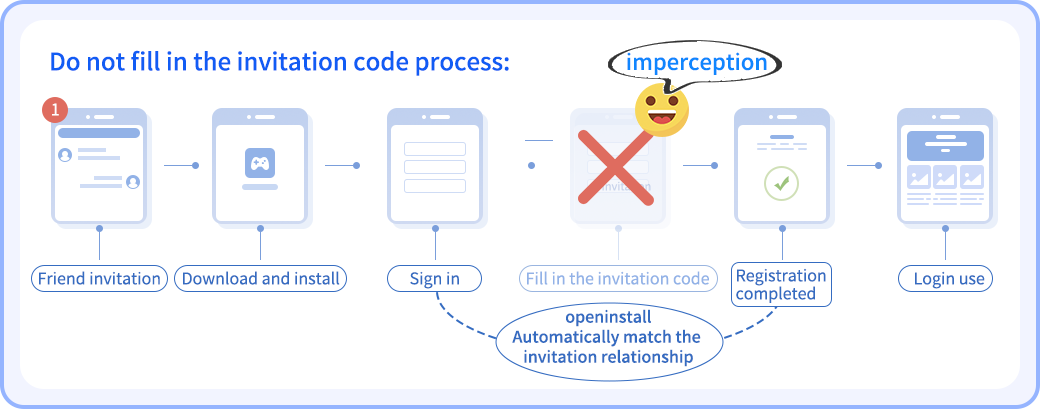
How to Achieve App User Growth by Eliminating the Need to Fill in the Invitation Code
- 2025.5.13 11:20
- openinstall
- Scene Analysis
What should we do when it’s getting harder and harder to conduct App promotion and referral marketing?
Despite the great efforts in acquiring new users, the results are still not obvious. Which link has actually gone wrong?
There is a high user churn rate. Are there any processes in the promotion that users find extremely annoying?

Against the backdrop of highly homogeneous App products nowadays, product details and user experience will become the key for an App to stand out in the industry competition. Today, from the perspective of user experience, we will have a detailed discussion on the problem of user churn caused by the invitation code filling process in the referral promotion of App products, as well as the solutions to this problem.
Problem: User Churn in Referral Marketing
The market is never short of growth channels, and the user invitation channel is particularly important among them. Nowadays, almost every App has developed an invitation function, aiming to constantly encourage existing users to convert potential users around them.
It is the dream of every product operator to make every individual user become a communication medium for the product and form intensive communication among potential users. However, in practice, the invitation and registration activities of some products often do not achieve good results and fail to generate a referral effect. Besides reflecting on the planning of the activities themselves, the user churn caused by the complicated invitation code process cannot be ignored. Reducing the invitation steps and optimizing the user operation experience will make the referral communication achieve twice the result with half the effort.
In traditional referral promotion, App products usually use the method of filling in an invitation code to verify the source of information, identify who specifically invited the new user, and reward the relevant old user (the inviter).
Filling in the invitation code: The principle is very simple. The inviter generates a unique invitation code and gives it to the new user to fill in. To make it convenient for new users to fill in, some developers have even invented methods such as self-selecting invitation codes.

The emergence of the invitation code filling process essentially only meets the statistical needs of developers and promotion personnel. It does not provide users with a smooth experience. Instead, it adds an extra step to the user installation journey, creating an additional layer in the funnel and increasing the possibility of potential user churn. Once old users think that the rewards are not significant enough, and new users are annoyed by the cumbersome “invitation code filling” process and choose to “give up registration” or “skip the invitation code”, the invitation and registration activity will end in failure.
Is it really worth sacrificing the conversion rate from exposure to installation to a certain extent just to obtain data?
Solution: Installation without Filling in the Invitation Code
In fact, there are corresponding technologies in China that can perfectly solve this problem. Before discussing the technology, we need to clarify a logic: Why does the user experience stop abruptly at the invitation code filling process? The main reason is that the traditional way of filling in the invitation code is done manually, and users are likely to lose patience at this step. As long as we change “manually filling in the invitation code” to “the program automatically fills in and skips the invitation process”, the problem will be naturally solved. This involves the application of the channel source tracking technology.
Here is a rough explanation of the principle of this channel source tracking technology:
- The developer integrates a third-party web SDK on the shared H5 page. When publishing the shared link, any custom parameters (such as promotion channel number, invitation code, game room number, etc.) are dynamically concatenated in the URL.
- When a certain terminal accesses the H5 page, the third-party web SDK will simultaneously determine the personalized information of the device and collect the custom parameters, and upload them to the third-party server. Then, use the Android/iOS SDK to retrieve the temporarily stored custom parameters from the third-party server.
- Developers can customize various dynamic parameters in the shared link according to their own needs. For example, by attaching the user ID of the App inviter in the URL of the shared link, the effect of not needing to fill in the invitation code can be achieved.
Based on this principle, App developers can accurately identify the source of each installation without the need for channel packaging and filling in channel identification codes (i.e., invitation codes, on-site promotion codes).
Value: Accelerating App User Growth
We know that in promotion, every additional step will lead to a certain amount of user churn. As long as this method is reasonably applied, the App promotion effect will surely be more efficient. From the user’s perspective, there is no need to enter complex and hard-to-remember invitation codes anymore, and the operation experience becomes fast and smooth, which will greatly increase the conversion rate and retention rate. For App developers, the program can automatically achieve accurate tracking of the installation source, which will also save a lot of effort.

The essence of not needing to fill in the invitation code is the tracking of the channel source. Since the tracking of the invitation source can be achieved, this technology can naturally be applied to countless fields. As long as there is a need for channel source monitoring or identification, it can be satisfied, such as: on-site promotion effect statistics, advertising effect statistics, etc. Currently, this application method has been verified in some markets, and there are still many potential application scenarios waiting to be explored.
Recent Posts
- OpenInstall Omnichannel Multi-scenario Solution
- Having trouble acquiring users and achieving conversions for your app? Here are solutions based on real-world examples.
- openinstall: A solution for attribution and redirection from web to app (W2A).
- How to efficiently use app data statistics
- In today’s wave of social networks, how should developers make good use of omni-channel statistics?
- ASA Attribution Statistics: Breaking Through the Gap in iOS Customer Acquisition Data from a Developer’s Perspective, Making Advertising Decisions More Traceable
- Openinstall Core Function Usage Guid
- What benefits can a Web to App attribution solution bring?
- IMore than just “data calculation”: The underlying logic of APP channel agent statistics is the key to doubling conversion efficiency
- How to Use App Install Parameters for Channel Attribution



